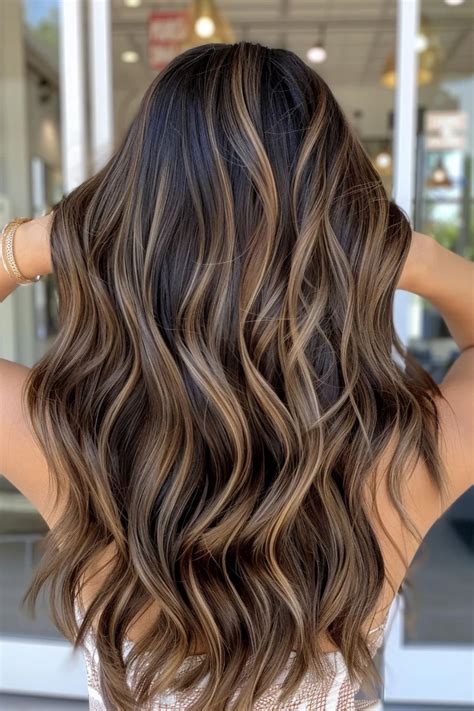Balayage hair colors have gained immense popularity in recent years as a low-maintenance and high-impact way to enhance your tresses. Unlike traditional highlighting techniques that involve a cap or foils, balayage is a freehand painting technique that creates natural-looking, sun-kissed highlights that effortlessly blend into your base color.

Why Choose Balayage?
Balayage offers numerous benefits that make it a compelling choice for hair color enthusiasts:
- Customized Color: Balayage allows hair stylists to create a personalized color that complements your skin tone, eye color, and hair texture.
- Natural-Looking Results: The freehand painting technique mimics the way the sun naturally lightens hair, resulting in a seamless and flattering transition from dark to light shades.
- Versatile: Balayage can be applied to any hair type and length, from short bobs to long, flowing locks.
- Low-Maintenance: Unlike traditional highlights, balayage requires less frequent touch-ups, as the blended nature of the color allows for a graceful grow-out process.
Balayage Techniques to Consider
There are several balayage techniques to choose from, each designed to create a specific effect:
Classic Balayage
This is the most common balayage technique, which involves painting highlights onto the hair with a sweeping brush motion. It creates a soft and subtle transition from dark to light shades.
Ombré Balayage
This technique combines balayage with ombré to create a gradual transition from one color to another. The result is a more dramatic look with a pronounced difference between the root color and the highlights.
Reverse Balayage
This unique technique reverses the traditional balayage process by darkening the ends of the hair and gradually lightening them towards the roots. It is ideal for clients who want to create a more edgy and modern look.
Balayage on Different Hair Colors and Textures
Balayage can be customized to flatter any hair color and texture:
Blonde Hair:
Balayage adds depth and dimension to blonde hair, creating a sun-kissed beachy look. Highlights can range from subtle honey tones to bold platinum streaks.
Brunette Hair:
Balayage enhances brunette hair by adding warmth and natural-looking highlights that brighten up the face. Caramel, toffee, and cinnamon shades are often used.
Red Hair:
Balayage can add vibrancy to red hair by creating subtle highlights that add depth and dimension. Copper, rose gold, and auburn shades are popular options.
Fine Hair:
Balayage is an excellent choice for fine hair, as it adds volume and movement without overwhelming the hair’s texture. Soft, gradual highlights are recommended to avoid creating a brassy or chunky effect.
Thick Hair:
Thicker hair can handle bolder balayage highlights. Contrasting colors with a more pronounced transition can create a striking and eye-catching look.
Balayage Hair Color Ideas
Here are some inspiring balayage hair color ideas to consider:
| Color | Description |
|---|---|
| Honey Blonde: Sun-kissed blonde highlights that add warmth and radiance | |
| Caramel Brown: Soft, natural-looking highlights that enhance brunette hair with depth and warmth | |
| Copper Rose: Rich copper-toned highlights with a hint of pink, adding vibrancy to brunette or red hair | |
| Ash Blonde: Cool-toned blonde highlights that create a soft, silvery effect | |
| Pumpkin Spice: Warm, autumnal shades of bronze and cinnamon that add a touch of spice to brown or blonde hair |
Common Mistakes to Avoid with Balayage
- Overdoing the Highlights: Balayage should create a natural, blended effect. Avoid over-highlighting, which can result in a brassy or chunky look.
- Using Too Much Bleach: Bleach can damage hair if used excessively. Opt for professional colorists who use gentle bleaching techniques and avoid DIY bleaching.
- Neglecting Toner: Toner is crucial after bleaching to balance the pH level of the hair and prevent brassiness. Ask your stylist about the best toner options for your hair color.
- Ignoring Hair Care: Balayage-treated hair requires proper care to maintain its vibrancy and health. Use color-safe shampoos and conditioners, and consider deep conditioning treatments regularly.
- Touching Up Too Often: Balayage’s longevity is one of its benefits. Avoid frequent touch-ups, as it can put unnecessary stress on your hair.
Frequently Asked Questions (FAQs)
1. How long does balayage last?
Balayage typically lasts 6-12 months, depending on the growth rate of your hair and the maintenance regimen you follow.
2. Is balayage better than traditional highlights?
Balayage offers a more natural-looking and low-maintenance alternative compared to traditional highlights.
3. Can I get balayage at home?
While DIY balayage kits are available, it is highly recommended to have a professional hairstylist perform the technique for optimal results.
4. How much does balayage cost?
The cost of balayage varies depending on the length of your hair, the complexity of the technique, and the location of the salon. On average, expect to pay $150-$500 for a full balayage.
5. What is the difference between balayage and ombré?
Ombré typically involves a more dramatic transition from dark to light shades, while balayage creates a softer and blended effect.
6. Can balayage damage my hair?
Balayage involves bleaching, which can damage hair if not performed properly. Choose professional stylists who use gentle bleaching techniques and take proper care of your hair after the procedure.
7. How often should I wash my hair after balayage?
Washing your hair less frequently helps preserve the color and prevent fading. Aim to wash your hair 2-3 times per week, using color-safe shampoos and conditioners.
8. Can I use a purple shampoo on balayaged hair?
Yes, purple shampoos can help neutralize brassiness and maintain the cool tones in balayage hair, but use them sparingly to avoid over-toning.
